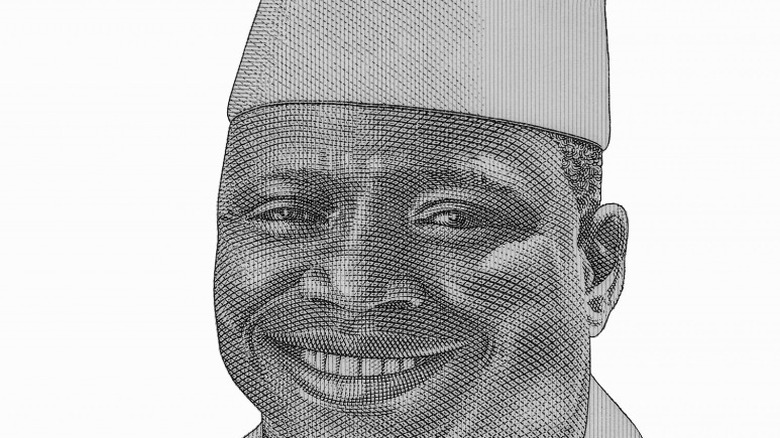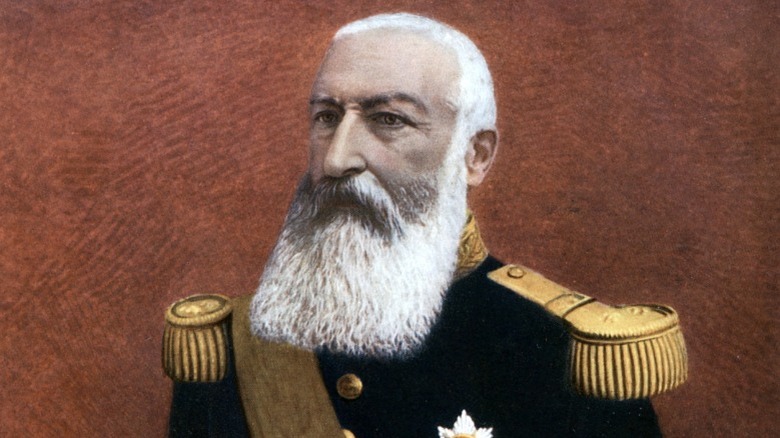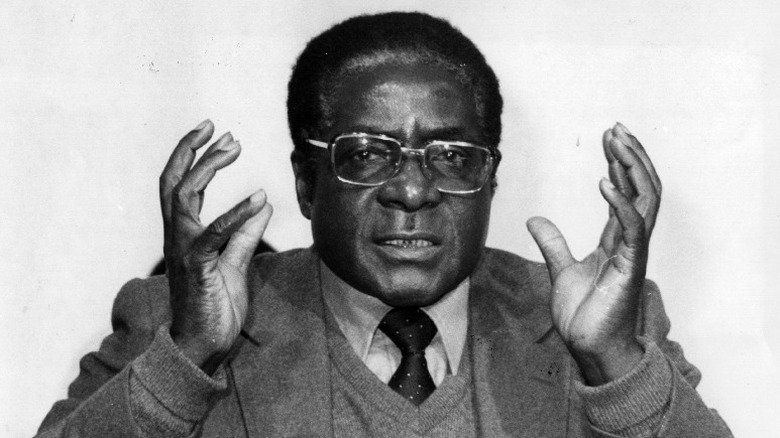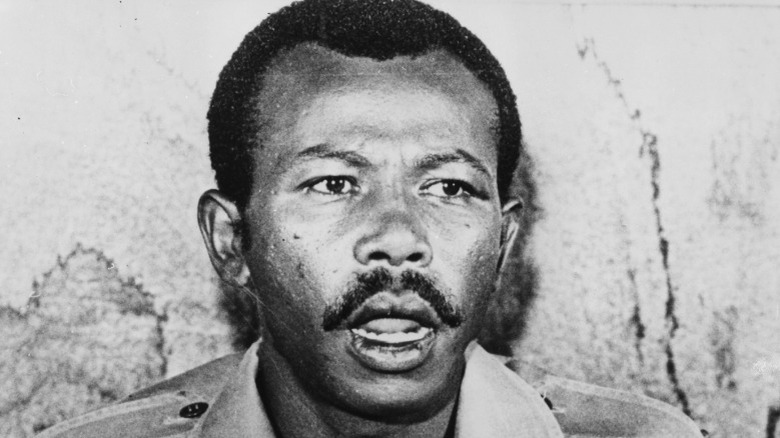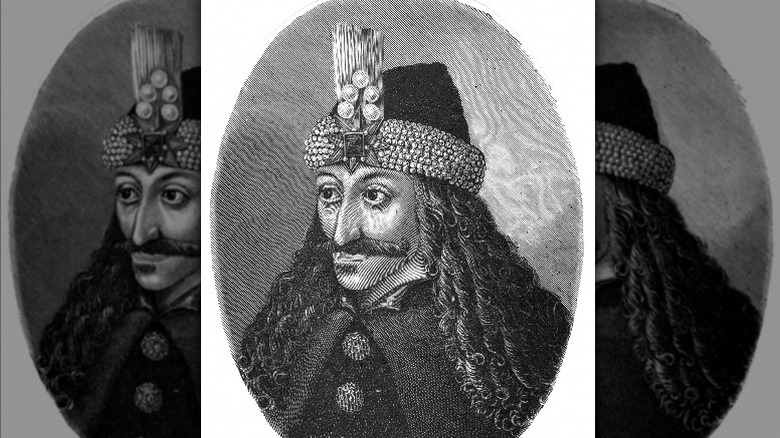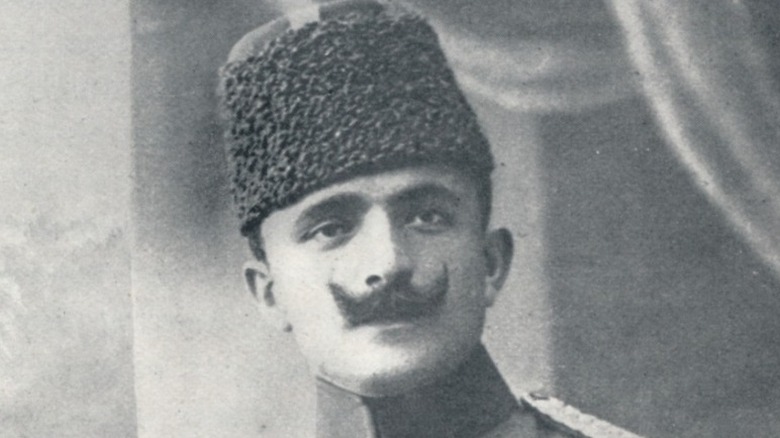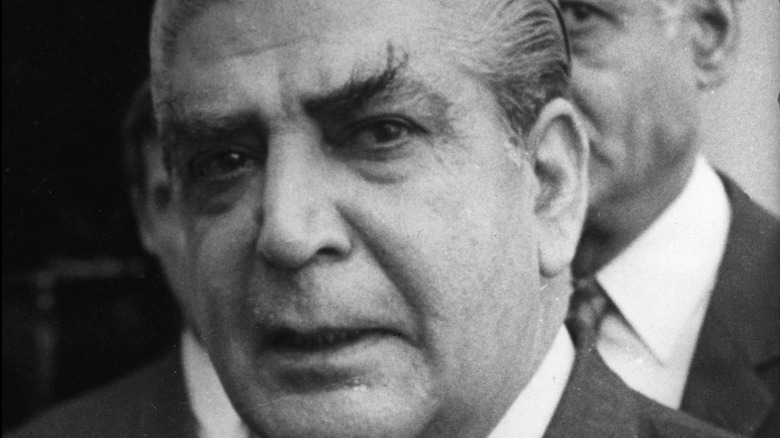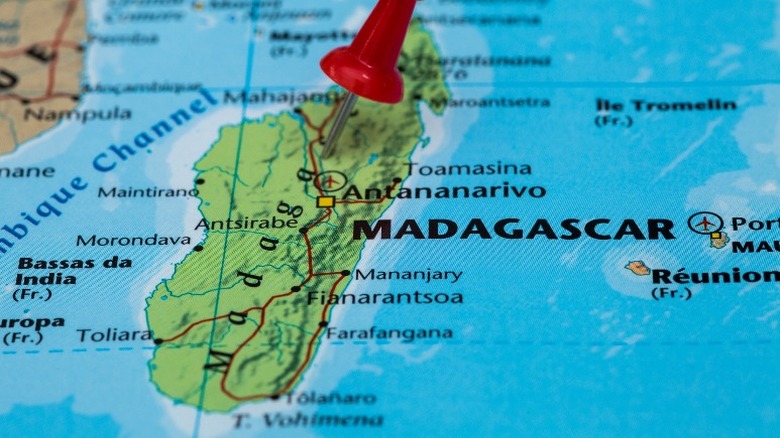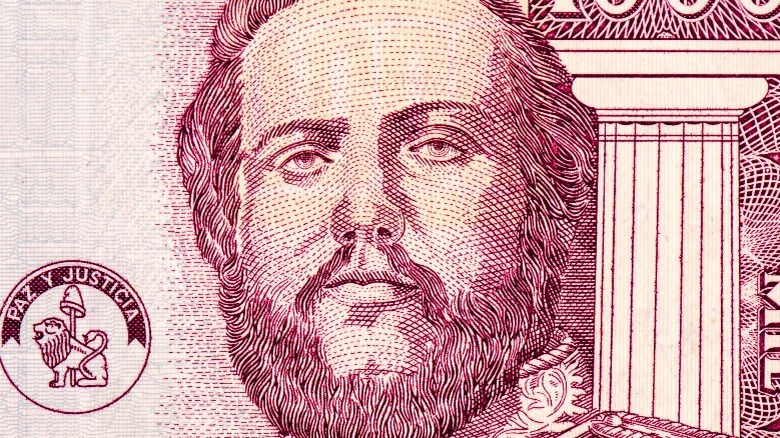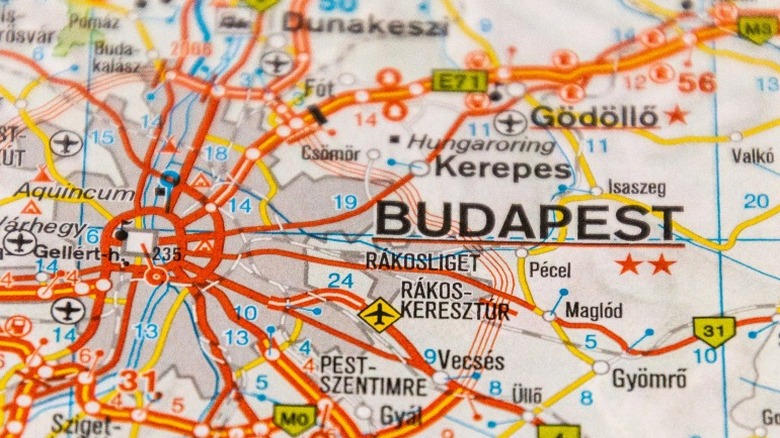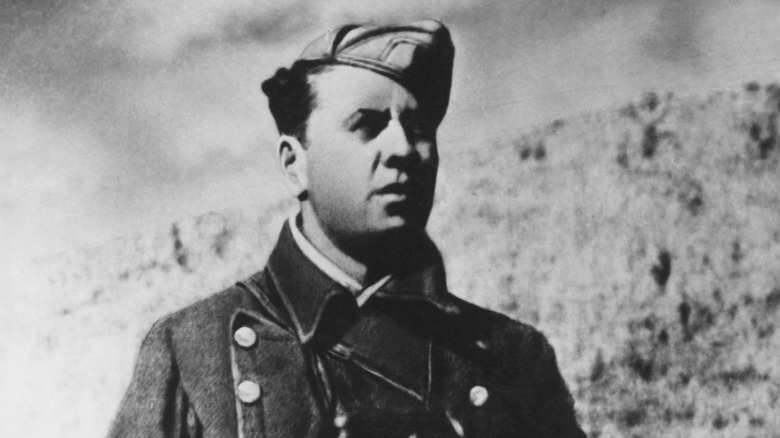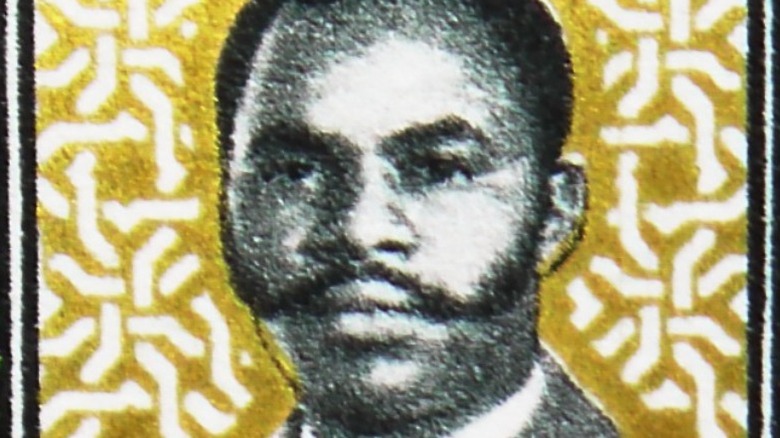Ruthless Dictators You Probably Haven't Heard Of
A 2018 study by the German agency Bertelsmann Stiftung revealed that even though the number of people living under a democratic government rose from 4 billion to 4.2 billion over the previous 15-year period, the number of the world's population living under dictatorships increased by over a billion in that same time frame to nearly 3.3 billion. According to The Local, the study concluded that developing nations are consolidating their power "at the expense of the liberty of their peoples."
Dictatorships are not limited to the likes of Adolph Hitler and Joseph Stalin, who co-starred in a mid-20th century competition on who could kill the most people. Indeed, there have been scores of dictatorships that might have been glossed over in your history books, if not left out entirely. For every Hitler and Stalin, there is a post-colonial Latin-American tyrant or obscure African continent dictator that wasn't on your radar during any high school or college history courses. While these power-hungry leaders might not have had the infamy or the death count of some of the most notorious rulers featured on the History Channel, they have certainly left their cruel mark on the world in ways that should never be forgotten.
Yahya Jammeh of Gambia
In July 1994, soldiers led by junior military officers stormed the seat of government in the African nation of Gambia, deposing the democratically elected president Dawda Jawara in a bloodless coup. Leading the coup was a career Gambian military man, Yahya Jammeh. The New York Times reports that Jammeh was a 29-year-old Lieutenant in the army who immediately began working with other military figures to establish the Armed Forces Provisional Ruling Council (via "A Political History of the Gambia 1816-1994"). This interim government gave way two years later when Jammeh was elected president (via Trial International).
For the next 20 years, Jammeh ruled the Gambia with an iron fist. He outlawed all oppositional political parties and began sending in military troops to attack any government protestors. According to The New York Times, Jammeh also worked to silence reporters whom he thought were working against him. Jammeh's war on the free press was particularly notable in 2004 when the BBC reported that the editor of The Point newspaper, Deyda Hydara, was gunned down in the Gambia. The outlet also mentions that the watch group Reporters Without Borders considered the Gambia an especially dangerous place to work, with constant surveillance and death threats.
Also known for his bizarre medical theories, Jammeh claimed to be able to cure AIDS with herbs. Jammeh lost his reelection bid in December 2016 and went into exile the following month to Equatorial Guinea.
Leopold II of Belgium
King Leopold II was the jealous type. In the late 19th century, the Belgian ruler felt left out of the game of colonialism that the English, French, and Spanish seemed to be so good at. Noting his European counterparts' cruel conquests of the Americas, Southeast Asia, and the African continent, Leopold hatched a plot to colonize the Congo region of Africa and usurp their natural resources to fund projects at home in Belgium.
On the surface, Leopold made every effort to appear like he was only trying to "civilize" the people of the region and aid them with modern improvements (per National Geographic). According to Britannica, he had illiterate Congolese leaders sign treaties that benefited only Leopold and successfully lobbied Western powers to recognize his ownership of a giant swath of central Africa. He named this private colony the "Congo Free State."
But these Congolese were anything but free. Leopold established an army he called the Force Publique and using these troops, he had villages raided, holding the women hostage so that the men could be forced to work harvesting rubber trees. When rebel factions began to appear, his Force Publique was instructed to slaughter them on site. One of his favorite ways of showing how many rebels were slaughtered was displaying their severed hands. The famine that ensued resulted in up to half the population dying from malnutrition, according to National Geographic.
Pressure from larger nations forced Leopold to relinquish the Congo in 1908.
Robert Mugabe of Zimbabwe
To understand the mixed bag of liberation and eventual tyranny that Robert Mugabe was known for, it's important to understand what it was like to live under the white-minority rule in Africa. Mugabe was born in Rhodesia (modern Zimbabwe), where less than 300,000 Europeans and their descendants wielded power over the approximately 6 million Africans (via the BBC). The white population was given the best farmland, resulting in the Black population being forced to farm nearly infertile ground.
Mugabe was imprisoned for 11 years as a result of a campaign he waged to end discrimination in Rhodesia (via History). After his sentence for sedition was served, he went into exile in Mozambique to regroup. Eventually, an agreement that the British government helped design led to allowing for majority rule so long as the rights and property of whites in the country were protected. When elections were held in 1980, Mugabe was elected to lead the new state of Zimbabwe.
As a liberator, Mugabe is hailed as someone who pushed oppressed people to become empowered. But Mugabe's 37-year rule was mired in controversy and brutality. In 2000, he sent in troops to capture farmland owned by whites. This led to many of them fleeing the country and the eventual collapse of commercial farming. The once prosperous economy was destroyed, and rival factions were beginning to rise against him.
Mugabe resigned in 2017 after impeachment proceedings were begun against him.
Mengistu Haile Mariam of Ethiopia
The brutal rule of Mengistu Haile Mariam began in 1974 when he and other military officials led a bloody junta against Emperor Haile Selassie, who ruled for the previous 44 years. Mariam, according to Human Rights Watch, immediately had about 60 of Selassie's senior officials executed by firing squad. Eventually, the head of the Orthodox Church was murdered, and Mariam was only beginning.
Thousands of young men and women — students that Mariam believed to be in opposition to him — were found murdered in the streets of cities all over Ethiopia. The executions were carried out by local watch groups called "Kebeles" that were under the thumb of Mariam. The Kebeles would force the families of murdered victims to pay for the bullets that killed their kin in exchange for the bodies of their slain loved ones.
When famine hit Ethiopia in 1984, Mariam did his best to block the news from the eyes of the world. Knowing that he had factions against him in the northern part of the country, he used the famine as an excuse to forcibly relocate hundreds of thousands of people from the land he thought hostile to his rule. Britannica reports that during this period, the once-friendly Soviet Union pulled its support for Mariam. This led to his eventual resignation in 1991 and his flight to Zimbabwe. He was tried for genocide and sentenced to death in absentia in 2008.
Vlad III of Walachia
Of all the dictators in this article, only one inspired the most well-known horror novel of all time. Vlad III of Wallachia, more commonly known as "Vlad the Impaler," is said to have been researched by Irish author Bram Stoker and served as the model for his title character in the 1897 novel "Dracula" (per Ancient Origins). Considered a mix of a folk hero to the people he protected and a brutal tyrant to those who were subjected to his cruelties, Vlad ruled the region of Wallachia three times in the 15th century.
This region of modern-day Romania was under constant siege from the Ottoman Turks. After coming to power in 1448, Vlad was quickly deposed after only two months. But after waging an eight-year campaign, he was able to resume power again in 1456, according to Britannica. The subsequent six-year rule was known for his resistance to the Turks and for the terror he unleashed on both foreign and domestic people he deemed as threats. Known for his penchant for inflicting cruel deaths on his enemies, Vlad ordered thousands impaled alive on stakes. HeritageDaily writes that Vlad is also responsible for the deaths of as many as 100,000 civilians.
Vlad lost power in 1462 and was imprisoned by the Hungarian government for the next 12 years. After his release, he regained power briefly in 1476 before being killed in battle shortly afterward.
Ismail Enver Pasha of the Ottoman Empire
General Ismail Enver Pasha was a leading general of the Ottoman government from 1913 until 1918. Britannica tells us that Pasha was considered a hero during the Turk rebellion against the Ottoman sultan in the early 20th century, which resulted in the formation of a constitutional government. Pasha also led his people to war against the Allied powers during World War I and fought against the newly formed Soviet Union following the war's end in 1918.
Though a hero in his early years, Pasha had a heavy hand in the genocide of both Greek and Armenian peoples. As part of the triumvirate known as the "Three Pashas," he was the military head of the Ottoman government and held power in conjunction with Talaat Pasha and Djemal Pasha. The Times of Israel credits these three with the deaths of more than 1 million Armenians during WWI, many of whom succumbed during a forced march to Syria.
All three were court-martialed after the war concluded. Pasha went to Turkistan to help organize the central Asian states. While there, he was killed in a battle with the Red Army of the Soviet Union, who had been dispatched to eliminate the insurgency that he was there to support.
Yahya Khan of Pakistan
Yahya Khan was responsible for Operation Searchlight — a military operation carried out in 1971 against the Bengali people in what Fair Observer calls a genocide. A military general that was given power by a flailing Pakistani president in 1968, Khan tried in vain to keep all of Pakistan united. This included the province known as East Pakistan, which had been under Pakistani control since British-held India was partitioned and Muslim majority areas were given to the Pakistani government in 1947 (via World Atlas). Angered that the Awami League had won a majority in the Pakistan National Assembly, Khan declared a state of martial law and had his generals move troops into the East as part of Operation Blitz. All opposition was to be taken out in major cities within a month, but it didn't go according to plan.
There was a continuous amount of unrest in East Pakistan, led by Bengali insurgents. Khan and his generals upped their game and conducted a follow-up campaign, Operation Searchlight, to stifle opposition, and it was a brutal one — International Affairs Review reports that at least 25,000 were killed in a single night. The military campaign led to the deaths of up to three million from East Pakistan, as well the displacement of up to 10 million people who fled to safety in bordering India.
Ranavalona I of Madagascar
Ranavalona I came to power in Madagascar shortly after the death of her husband, Radama. One of 12 wives, Ranavalona had no legal claim to his throne, which at first went to one of Radama's nephews. But the reforms that Radama had brought to the island nation angered the elites of the nation, and they did not want this to continue under the newly crowned Prince Rakotobe (via Ancient Origins). The wealthy worked with the military to seize the throne from Rakotobe and install Ranavalona as queen.
Ranavalona began to immediately eliminate threats to her throne by putting Rakotobe and his mother to death. Other political rivals soon met the same fate. The queen then began undoing many of the reforms her late husband had established in an attempt to rid Madagascar of Westernization from colonial European powers. European diplomats were expelled from the island, along with them any merchants and teachers. When the French army launched an attack, her army put it down, and she had the heads of French soldiers put on pikes as a warning. She was particularly cruel to Christian missionaries, whom she had tortured to death. Her reign is also marred by the labor she forced on her subjects, which was tantamount to enslavement.
History has judged Ranavalona in different ways. She ruled during a time that witnessed the cruel colonialism from Europe sweeping through Africa. Though she could have been a radical isolationist, she also might have been trying to save her country from colonialism.
Francisco Solano López of Paraguay
Francisco Solano López might have a better entry in the annals of history if he stayed out of the affairs of neighboring countries. Britannica writes of López wanting to make a name for himself as a great arbitrator on the South American continent, so he meddled in a civil war in neighboring Uruguay. Unfortunately for López, Brazil and Argentina were also involved in the war being waged on the landmass that they shared. And to make matters worse, the side that López backed in Uruguay lost. This resulted in the winning faction joining forces with Brazil and Argentina and uniting against Paraguay in the Treaty of the Triple Alliance.
According to Global Security, the resulting war against Paraguay was the bloodiest in South American history. López had the largest standing army on the continent at the time, but they were not well-trained or disciplined. As a result of their defeats on the battlefield, López had many of his troops shot or tortured in hopes to motivate the rest. Thousands of his troops were lost in this way. Though López was able to invade Brazil, his army took heavy casualties, and he began using forces made up of slaves and children for defense.
López was killed in battle in 1870, ending the war and beginning a period of foreign occupation. In five years, the population of Paraguay decreased from 1.3 million to just over 220,000.
Döme Sztójay of Hungary
Dome Sztójay was a puppet dictator installed by Nazi Germany during the final days of WWII. According to Nuremberg, when Nazi forces invaded Hungary in June 1944 and forced the resignation of the ruling government, Sztójay was installed as the new prime minister. He went to work immediately on the behalf of his German puppet masters, legalizing the Fascist Arrow Cross Party in his country. Sztójay then sent troops to the Eastern Front to protect Hungary from Soviet forces.
If using his military as fodder against Allied forces wasn't bad enough, Sztójay began a widespread persecution of Jews in Hungary. Many were sent to fortify the front, while others were placed into forced labor camps. Those who weren't on the front were rounded up and sent to Auschwitz. It's estimated that he sent nearly half a million Jews to this notorious death camp.
Thankfully, his rule was short. In October 1944, Hungary experienced a coup, and Sztójay was not given any position in the new administration. He laid low, then fled to Germany in April 1945, where he surrendered to U.S. troops. In October 1945, he was extradited to Hungary, where he was put on trial for war crimes. A tribunal found him guilty after a week-long trial in March 1946. He was put to death by firing squad (per the United States Holocaust Memorial Museum).
Enver Hoxha of Albania
Albania's chaos during World War II helped to form Enver Hoxha into the cruel dictator that he would become. A teacher by trade, he was forced to leave his post in education in 1939 following the Italian invasion of Albania after he refused to join the Albanian Fascist Party (via Britannica). He opened his tobacco store, which attracted a cell for the Communist Party. When the Germans invaded Yugoslavia in 1941, communists who fled that country aided Hoxha in forming the Albanian Communist Party (aka Party of Labour). When Albania was liberated in 1944, Hoxha became prime minister.
Hoxha held this post for 10 years before serving as the first secretary of the Communist Party's Central Committee and retaining power. He began instituting radical reforms in post-war Albania that resulted in near self-efficiency and reliance on crops and investment in an industry that would end up being almost half of Albania's gross national product by 1980. The tactics that Hoxha utilized is why history looks at him through a negative lens — the seizure of private property, the collectivization of farms, and the banishment of religion were reminiscent of Stalin.
Open Democracy tells of Hoxha's increasing paranoia that made the economy eventually dive. He began executing perceived political rivals, killing priests who were caught doing baptisms, and spending a lot of government money building unneeded bunkers to protect his people from imaginary invaders. Further harming his country, Haxha severed ties with both the Soviet Union and China. Hoxha went into semiretirement in 1981 until his death in 1985.
Michel Micombero of Burundi
Michel Micombero was an army captain when he led a coup against the ruling monarchy in the tiny east African nation of Burundi in 1966. The monarch at the time was out of the country and lived in exile until he attempted to return to Burundi in 1972. The New York Times writes that the monarch was killed during this attempt after Micombero accused him of trying to gather forces to return to power. This event led to a civil war in Burundi, in which the Tutsi majority fought against the Hutu population.
While the Hutu were responsible for the deaths of almost 2,000 Tutsi, the Tutsi response was bloodier. With Tutsis dominating the army and the police, Britannica states that Hutus were rounded up and summarily executed. It's estimated that as many as 200,000 Hutu were killed in what has been described as a genocide. After another 100,000 fled Burundi, the nation was left almost completely vacant of Hutu people.
The Washington Post tells of how Micombero was ousted in 1976 during a bloodless coup. His successor, Lt. Col. Jean-Baptiste Bagaza, led the coup, citing Micombero's corruption and fraud as the basis for his removal. Micombero lived in exile in Somali, where he died of a heart attack on July 16, 1983, at age 43.

